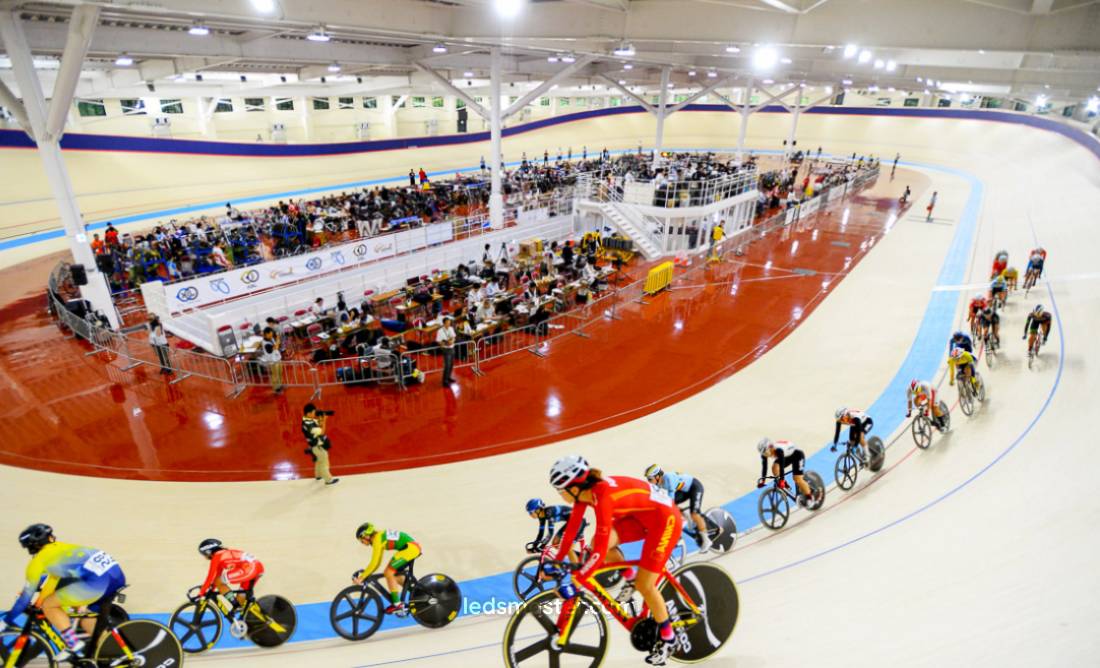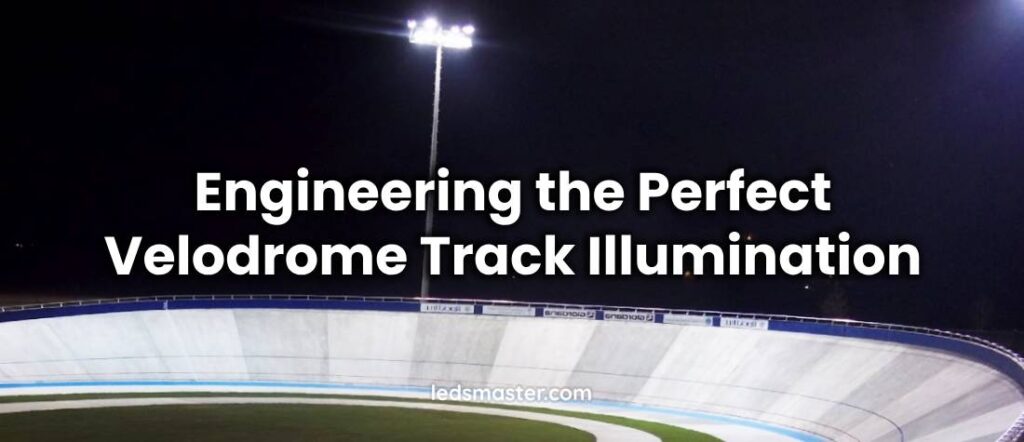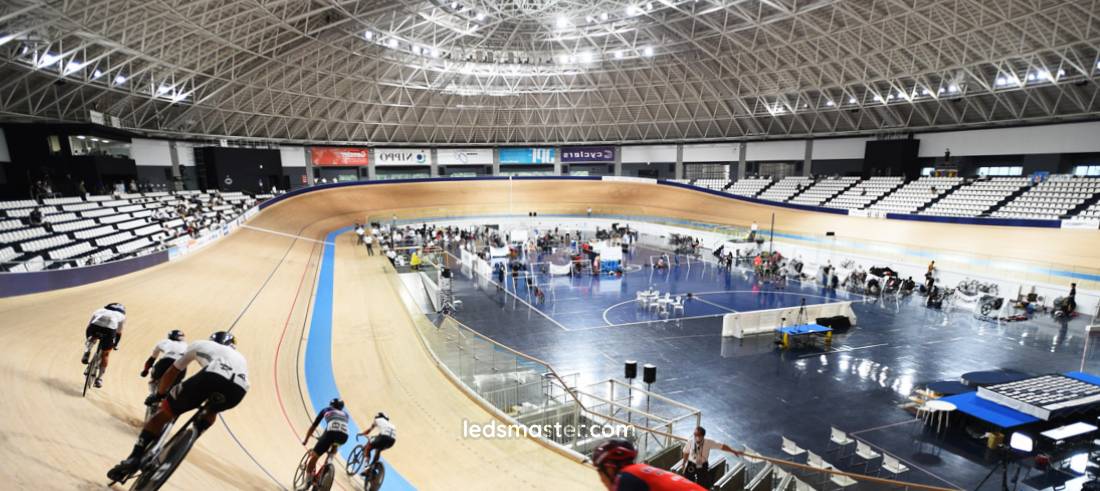Lighting in sports venues, especially for indoor tracks like those in velodromes, plays a crucial role in ensuring optimal visibility, enhancing the atmosphere, and providing the proper environment for athletes and spectators. Properly designed lighting helps in improving performance, maintaining safety, and creating an engaging experience. This topic addresses various aspects of lighting design and control systems, their costs, and the importance of the lighting system in velodrome settings.
Table of Contents
ToggleUnderstanding Velodrome Lighting Design
Elements of Velodrome Lighting Design
Velodrome lighting design revolves around the illumination of the track and surrounding areas, considering factors such as light intensity, uniformity, and color temperature. These factors help ensure that athletes can see clearly while performing, while also supporting the spectators’ viewing experience. Lighting is designed to meet the needs of both athletes racing on the track and those watching from the stands. For the track itself, high illumination levels are required, particularly during night events or in indoor settings. To achieve this, designers select appropriate lighting fixtures such as floodlights or specialized track lights.
The design focuses on achieving a well-distributed lighting pattern. Uniformity of light helps reduce shadows and ensures that all areas of the track are visible at all times. Furthermore, the glare from lights is minimized to prevent distractions or discomfort for athletes and viewers. The lighting system is typically engineered to allow for different levels of brightness, which can be adjusted based on event requirements, whether it’s a regular race or a high-profile championship.
Light Control Systems for Velodromes
Modern velodromes are equipped with advanced control systems that allow for dynamic adjustments to lighting levels. These control systems enable operators to regulate light intensity in real-time, adjust the color temperature, and ensure even distribution throughout the venue. Advanced systems may also allow for zonal lighting, where different areas of the venue (track, audience, VIP sections, etc.) are illuminated to varying degrees, depending on the specific needs of the event.
The ability to manipulate the lighting quickly provides flexibility. During different segments of an event, such as athlete introductions, pre-race routines, or victory celebrations, different lighting moods may be needed. Some velodromes also incorporate programmable lighting that can interact with video feeds, making the venue more engaging by synchronizing lighting with music or other visuals.
Factors Influencing Lighting System Costs
The cost of lighting systems in velodromes is influenced by several key factors that can significantly impact the overall budget. Understanding these factors can help venues plan and allocate resources more efficiently while ensuring optimal lighting for both performance and ambiance. Below are the primary considerations when determining velodrome lighting system costs:
Venue Size and Layout
The size and layout of the velodrome are critical factors in determining lighting needs. Larger venues require more lighting to adequately illuminate the entire track, spectator areas, and other spaces. For smaller indoor velodromes, fewer fixtures and lower overall lighting power may be sufficient, leading to lower costs. In contrast, larger velodromes—especially those designed for international competitions—require a more comprehensive lighting system to ensure uniform brightness across the venue, which can significantly increase the cost.
Type of Lighting Fixtures
The choice of lighting fixtures plays a significant role in the cost structure of a lighting system. Traditional lighting technologies like halogen or metal halide lamps tend to be cheaper upfront but are less energy-efficient, have shorter lifespans, and require more maintenance. LED fixtures, on the other hand, are more expensive initially but offer long-term benefits such as reduced energy consumption, longer lifespan, and lower maintenance costs. The price for each lighting fixture can vary greatly depending on the type and quality, with LEDs generally being the more cost-effective option in the long run.
Control Systems and Automation
Advanced control systems for lighting are another substantial factor influencing overall costs. These systems allow for dynamic adjustment of lighting levels, color temperatures, and zonal lighting. They are essential for accommodating different types of events, from training sessions to high-stakes competitions. These systems can also synchronize lighting with other venue technologies, such as multimedia displays, enhancing the event experience. The complexity of the control system will impact its cost, with larger or more intricate setups requiring a higher budget.
Installation Complexity
The installation of a lighting system in a velodrome requires careful planning and execution. The complexity of the installation depends on factors such as the size of the venue, the architectural layout, and the type of lighting fixtures being used. In smaller venues, installation may be straightforward and relatively inexpensive, but in larger or more complex venues, installation costs can increase substantially. Specialized equipment, structural considerations, and the need for a high level of expertise can all contribute to higher installation costs.
Maintenance and Longevity
Ongoing maintenance is another important consideration when determining the overall cost of a lighting system. Regular maintenance ensures that the system functions efficiently and prevents costly repairs in the future. Lighting systems, especially those using LEDs, require less frequent maintenance, but some systems—particularly those used in larger venues or high-profile events—might require more attention. Maintenance costs typically include the inspection, cleaning, and replacement of components, and they can vary depending on the scale and complexity of the system.
Type and Frequency of Events Hosted
The specific needs of the venue and the type of events it hosts can also affect lighting costs. Velodromes that host major international competitions or televised events require more advanced lighting systems capable of meeting broadcast standards and providing high-quality lighting for athletes and spectators. These venues may require specialized lighting setups that offer precise control over brightness, color temperature, and even the ability to change lighting levels for different parts of the track. Velodromes used for local races or training sessions, on the other hand, may have more basic lighting requirements, resulting in lower overall costs.
Long-term Cost Considerations
Although the initial setup of a lighting system can be costly, the long-term financial considerations are more manageable, especially when energy-efficient technologies like LED lighting are used. LED lights are known for their longevity, lasting up to 50,000 hours or more, which can equate to over 10 years of use depending on how frequently the venue is used. This longevity contrasts with traditional lighting, which may need to be replaced every 2 to 3 years, incurring additional costs for bulbs and labor.
Another major benefit of LED lights is their energy efficiency. LEDs consume significantly less electricity than traditional lighting systems. A venue that switches to LED lighting can expect to see a reduction in energy costs by up to 60% to 70%. The savings on electricity bills can quickly offset the initial higher cost of the LED fixtures, with many venues recouping their investment in as little as 5 to 7 years.
In addition to energy savings, LED lighting also reduces maintenance costs. Since LEDs last much longer than traditional bulbs, the need for frequent replacements is eliminated. The advanced control systems used in modern velodromes also assist with maintenance by providing real-time feedback about the status of the lights. These systems can alert operators to any malfunctioning lights or areas requiring attention, allowing for more efficient repairs. The maintenance costs for a LED-based system are lower than for traditional systems, typically ranging from $3,000 to $8,000 annually, depending on the size and complexity of the system.
When considering the long-term financial impact, it becomes clear that while the initial investment in a high-quality lighting system might be significant, the overall cost of ownership is much lower over time, especially when factoring in energy savings, reduced maintenance, and longer lifespans. By choosing LED lighting and advanced control systems, velodromes can significantly reduce their operating expenses while ensuring that the lighting system continues to perform optimally for many years.
The following table summarizes the cost breakdown for a typical velodrome lighting system:
| Factor | Estimated Cost Range |
|---|---|
| Size of Venue (Lighting Fixtures) | $50,000 – $300,000 |
| Lighting Fixtures (LED) | $500 – $2,000 per fixture |
| Lighting Control Systems | $20,000 – $150,000 |
| Installation Costs | $10,000 – $100,000 |
| Annual Maintenance | $5,000 – $10,000 |
The transition to more efficient lighting systems can also lead to additional long-term savings that help offset the initial costs. Overall, velodromes that invest in modern, energy-efficient lighting solutions benefit not only from lower operational costs but also from improved performance, both for athletes and spectators.
Why Lighting is Needed in Velodrome Tracks
Enhancing Athlete Performance
The main purpose of lighting in a velodrome is to ensure that athletes can see clearly and perform at their best. Proper lighting allows cyclists to maintain focus on their track and surroundings, ensuring that their speed and movements are not impaired by shadows or uneven lighting. In indoor velodromes, especially where there is no natural light, the quality of artificial lighting becomes even more important.
In outdoor velodromes, proper lighting ensures that races can continue even after the sun sets. The ability to maintain visibility throughout the race, regardless of the time of day, is crucial for both safety and performance. Athletes need a consistent and reliable light source to make quick decisions during races, avoiding sudden turns or obstacles in low visibility conditions.
Spectator Experience
For spectators, whether they are attending an event live or watching a broadcast, lighting plays a significant role in creating an immersive atmosphere. Well-designed lighting enhances the visual appeal of the event, adding to the excitement and energy. On a broadcast, the lighting must not only illuminate the track but also contribute to the overall aesthetic of the event. Lighting that is too harsh or poorly distributed can create distracting shadows, whereas lighting that is too dim can reduce visibility, both for the live audience and those watching on television.
Lighting can also be used strategically to create a sense of drama or anticipation. For example, highlighting key moments such as the start of a race or the podium ceremony with dramatic lighting effects can enhance the spectator’s emotional connection to the event. In this way, lighting design and control contribute significantly to the overall enjoyment and engagement of the audience.
Safety Considerations
Another key function of lighting is to ensure the safety of both athletes and spectators. For athletes, clear visibility helps prevent accidents that might occur due to insufficient lighting. In the fast-paced environment of velodrome racing, being able to see the track clearly at all times is critical for avoiding collisions or sudden changes in direction that could lead to injury.
For spectators, proper lighting also ensures safety, especially in the event of an emergency evacuation or while navigating through the venue. A well-lit environment makes it easier for people to move safely, whether they are seated in the stands or leaving the venue at the end of an event. Furthermore, lighting systems with emergency backup functionality can ensure that safety lighting is maintained during power outages or other unforeseen circumstances.
The Usage of Lighting in Velodrome Track Events

Supporting Different Types of Events
Velodromes host a variety of events, ranging from training sessions to professional competitions. Each event type may have specific lighting requirements based on the nature of the event and the number of people in attendance. For example, during international races, the lighting system needs to provide maximum visibility across the track, ensuring that every detail of the race is visible for both athletes and spectators. On the other hand, training sessions may require lower light levels, focusing on the track’s core areas where athletes need to train.
Lighting also serves to enhance the atmosphere of the venue. During major events, lighting systems can be used to create an exciting, immersive environment that adds to the spectacle. A well-lit venue helps energize both athletes and spectators, contributing to the overall excitement of the event.
Day-to-Night Transition
In outdoor velodromes, lighting systems are essential to manage the transition from day to night. During daylight hours, natural light may provide sufficient illumination for races, but as the day progresses, the need for artificial lighting increases. A well-designed lighting system ensures that there is no disruption in the quality of light as the sun sets, allowing for a seamless transition. Properly controlled lighting systems can also accommodate different phases of an event, adjusting the lighting levels to maintain the appropriate mood or intensity.
Energy Efficiency in Velodrome Lighting
With the growing emphasis on sustainability and energy conservation, velodrome lighting has evolved to become more energy-efficient. LEDs are now the standard choice for many modern velodromes, providing high-quality illumination with lower energy consumption compared to traditional lighting sources. Not only do LEDs help reduce the environmental impact of the venue, but they also contribute to lower operating costs. Additionally, the longer lifespan of LED lights reduces the frequency of replacements, further reducing maintenance costs.
Advanced lighting control systems also allow operators to optimize energy usage by adjusting the intensity of the lighting based on the specific needs of each event. This flexibility ensures that energy is not wasted and that the venue’s lighting system operates efficiently.
The Impact of Lighting on Broadcast and Media Coverage
Enhancing Broadcast Quality
Lighting in velodromes plays an important role in broadcast quality. Proper lighting ensures that the track, athletes, and surrounding areas are captured clearly and sharply on camera. Poor lighting can create visual inconsistencies, such as shadows or overexposed areas, which detract from the viewing experience. High-quality lighting helps cameras capture every detail of the race, improving the viewer experience and providing an accurate representation of the event.
Broadcast lighting also extends to the venue’s surroundings, including any branding or advertising placed in the venue. Well-illuminated advertising panels or sponsor logos can help enhance the venue’s commercial appeal, making the event more attractive to sponsors and broadcasters.
Integrating Lighting with Media Elements
Modern velodromes often integrate their lighting systems with other media elements, such as video displays or live streaming setups. Lighting can be programmed to interact with these media elements, creating a dynamic environment that enhances the visual experience for both spectators and viewers at home. For example, synchronized lighting can accompany live music, promotional videos, or opening ceremonies, creating a vibrant atmosphere that enhances the overall event experience.
Incorporating lighting into the broader media experience has become an essential part of creating a multi-sensory, engaging event. When done correctly, the integration of lighting with video feeds, music, and other media elements enhances the emotional impact of the event and engages the audience on multiple levels.
Conclusion
In velodromes, effective lighting design and control systems are fundamental to providing clear visibility, enhancing performance, and creating an engaging atmosphere for both athletes and spectators. The right lighting system ensures optimal safety, supports various event types, and contributes to an exciting, immersive experience. While the initial costs can be significant, the long-term benefits of energy efficiency, reduced maintenance, and enhanced event presentation make modern lighting systems a valuable investment. As velodromes continue to evolve, integrating advanced lighting technologies with media elements will further enrich the overall event experience, benefiting both participants and audiences alike.


